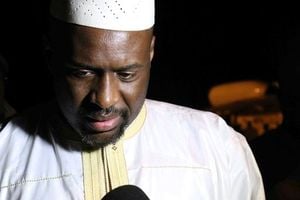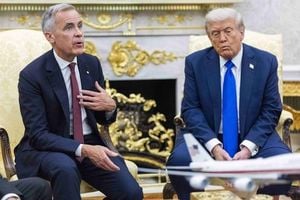Since the eruption of Israel’s latest war on Gaza, a battle over names has unfolded alongside the violence, exposing the deep fractures in Israeli political discourse and the shifting sands of U.S.-Israeli relations. What’s in a name? For Israel’s leaders, quite a lot. The campaign was first christened “Swords of Iron,” a moniker that, according to Abdaljawad Omar writing for Birzeit University, evoked the language of force and the mythos of statehood—the glint of imported American iron and the dream of unbreakable security. But as the war dragged on, with its objectives and justifications mutating almost daily, the search for the right appellation became a telling obsession in Israeli politics.
Prime Minister Benjamin Netanyahu, never one to miss a chance for grand narrative, floated a new name: the “War of Redemption.” As Omar observes, this wasn’t just a rebranding exercise, but a desperate, even theological move—an attempt to recast political brutality as a kind of divine necessity. For Netanyahu, the language of redemption offers a moral alibi, allowing him to transform disaster into destiny and to script himself as both the nation’s savior and survivor. “Redemption isn’t a matter of repentance or transcendence, but endurance,” Omar writes, suggesting that this framing allows Netanyahu to convert ongoing crisis into a kind of twisted national calling.
The Israeli military, meanwhile, prefers the more clinical “October 7 War,” anchoring the conflict to the traumatic date of the Hamas-led attack that sparked this latest round of violence. This choice, perhaps, signals an effort to fix Israel’s moral position in its own moment of suffering, a familiar psychology of perpetual victimhood that has long shaped the nation’s narrative.
But underneath these naming debates lies a deeper, more unsettling reality. As Omar argues, the war is “unwinnable and ongoing,” its goals shifting with every press conference and its justifications changing with each new image of destruction from Gaza. Victory is declared and retracted in the same breath, and the violence—far from bringing closure—seems to have become the very condition of Israel’s political being. “To stop fighting would be to discover that the war was never a passage to salvation but the condition of Israel’s political being,” Omar writes, highlighting the paradox of permanence through crisis.
As the war rages on, the world watches—no longer captive to the old fictions of security and self-defense. Livestreamed images from Gaza have made abstraction impossible. Even former U.S. President Donald Trump, never known for self-reflection, has conceded that Netanyahu has lost international support. “You cannot bomb your way to legitimacy, and you cannot fight the world and win,” Omar notes. Yet, Netanyahu’s power depends on exactly this illusion: the need for an enemy vast enough to sustain his myth, whether that’s Iran, Hamas, or, increasingly, the world itself.
While Israel’s leaders wrestle with narrative and legitimacy, the suffering in Gaza remains relentless. In the week prior to October 27, 2025, a high-powered delegation of Trump administration officials—including Vice President Vance, Secretary of State Rubio, and envoys Jared Kushner and Steve Witkoff—traveled to Israel. Their mission: to ensure Netanyahu stuck to Trump’s Gaza “peace plan,” which both Israel and Hamas had, under significant U.S. pressure, agreed to. According to revcom.us, Trump had to strong-arm Netanyahu into signing the plan, threatening to “no longer stand with Netanyahu” if he didn’t comply.
But peace proved elusive. On October 19, Netanyahu’s government accused Hamas of killing two Israeli soldiers in Rafah, launching retaliatory airstrikes that killed 45 people. Hamas denied responsibility, and this marked the 48th Israeli violation of Trump’s ceasefire and peace plan in just nine days. The U.S., increasingly concerned Netanyahu might unravel the agreement, took extraordinary measures. The U.S. Central Command established a Civil-Military Coordination Center in southern Israel to monitor the ceasefire and maintain pressure on Israel. American drones began flying over Gaza, and U.S. officials demanded advance notice of any major Israeli military actions.
Meanwhile, the Israeli Knesset advanced measures to annex the occupied West Bank, home to 3.3 million Palestinians—a direct challenge to Trump’s plan. Trump called the annexation “a very stupid political stunt” and a “threat to the peace process,” while Vance and Rubio echoed these rebukes. Yet, as revcom.us points out, the U.S. has long supported Israeli settlements and attacks on Palestinians in the West Bank. The real issue, they argue, is the maintenance of U.S. imperial interests in the region, with Israel playing a “special role” as a heavily armed bastion of American power. The U.S. supplies 68 percent of Israel’s foreign-sourced weapons, underscoring this deep dependency.
Trump’s so-called “peace plan,” critics argue, is less about ending Palestinian suffering and more about preserving their subjugation, strengthening Israel, and extending U.S. dominance in the Middle East. The plan envisions closer alliances with regional powers like Saudi Arabia, Turkey, and the United Arab Emirates, but Israel’s ongoing threats to annex the West Bank and resume its Gaza offensive threaten to derail these ambitions.
Despite the ceasefire, the humanitarian catastrophe in Gaza persists. More than half the population remains displaced, living in tents or the shells of bombed-out buildings. The infrastructure—homes, schools, hospitals, water and sewage systems—has been decimated. Over the last two years, Israeli military action has killed at least 68,229 people in Gaza, including 20,000 children, according to revcom.us. The toll on children is especially harrowing: 56,000 have lost at least one parent, and thousands more have lost both. UNICEF reports that 40 percent of Gazan families are now raising children who are not their own.
On October 24, two brothers, Said and Mas’oud al-Ghawash, were killed in an Israeli airstrike east of Der el-Balah, and the next day, four more Palestinians were injured in Central Gaza. Israeli security measures remain harsh—even children and animals that accidentally cross into “no-go” zones have reportedly been targeted, following demands from Israel’s national security minister.
The ceasefire has failed to bring adequate relief. Under Trump’s plan, 600 trucks of food, medicine, water, and other aid were supposed to enter Gaza daily, but the United Nations reports that fewer than 100 trucks arrive on average. Israel continues to block or “arbitrarily” reject desperately needed aid, including tents, blankets, food, and medical supplies. The World Health Organization has described Gaza’s starvation crisis as “catastrophic,” and the International Court of Justice has ordered Israel to restore access for UN agencies to deliver basic necessities.
Even the land itself has suffered: nearly one million of Gaza’s olive trees—a symbol of livelihood and tradition—have been destroyed by bulldozers or drought. The healthcare system lies in ruins, making it nearly impossible to identify the dead or care for the wounded. A recent funeral for 54 Palestinian prisoners returned by Israel was a somber affair, with families unable to identify their loved ones due to the extent of injuries and lack of medical resources.
As the war grinds on, its end seems as elusive as ever. The struggle over names—whether “Swords of Iron,” “War of Redemption,” or “October 7 War”—mirrors a deeper struggle over meaning, legitimacy, and the future of the region. For now, the suffering continues, and the world’s gaze remains fixed on Gaza, searching for answers in a landscape scarred by violence and haunted by the ghosts of broken promises.




